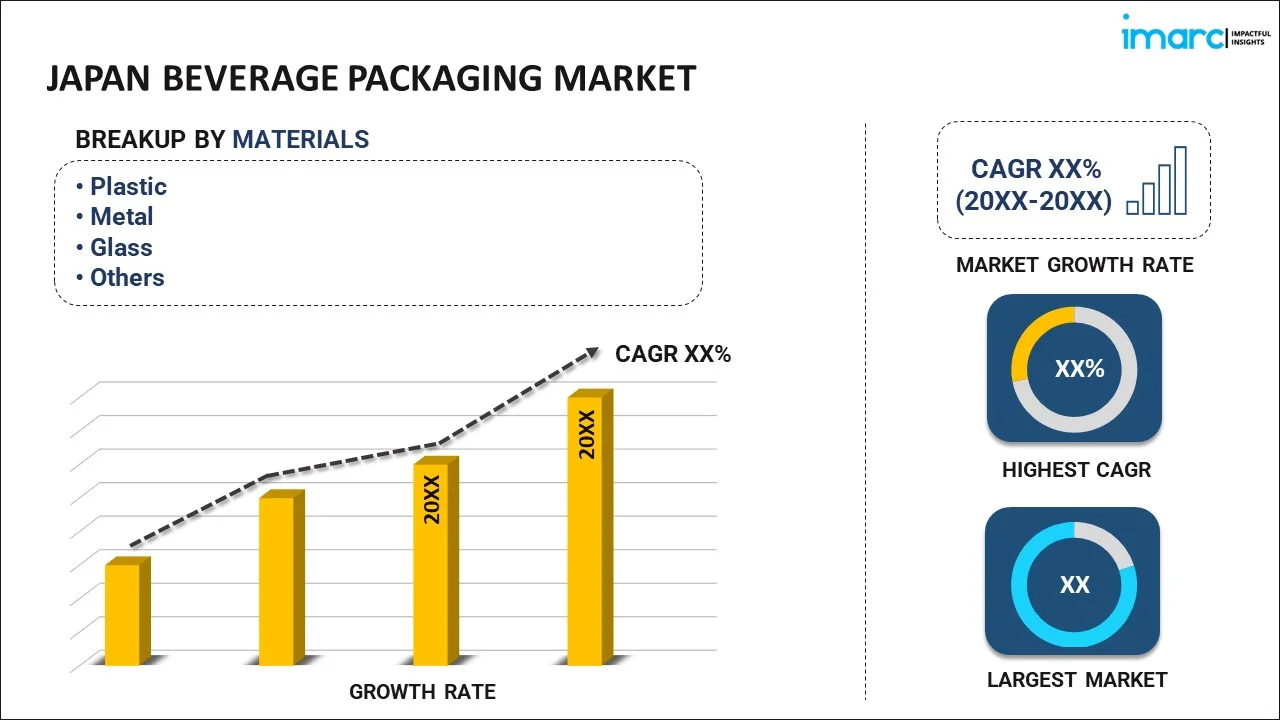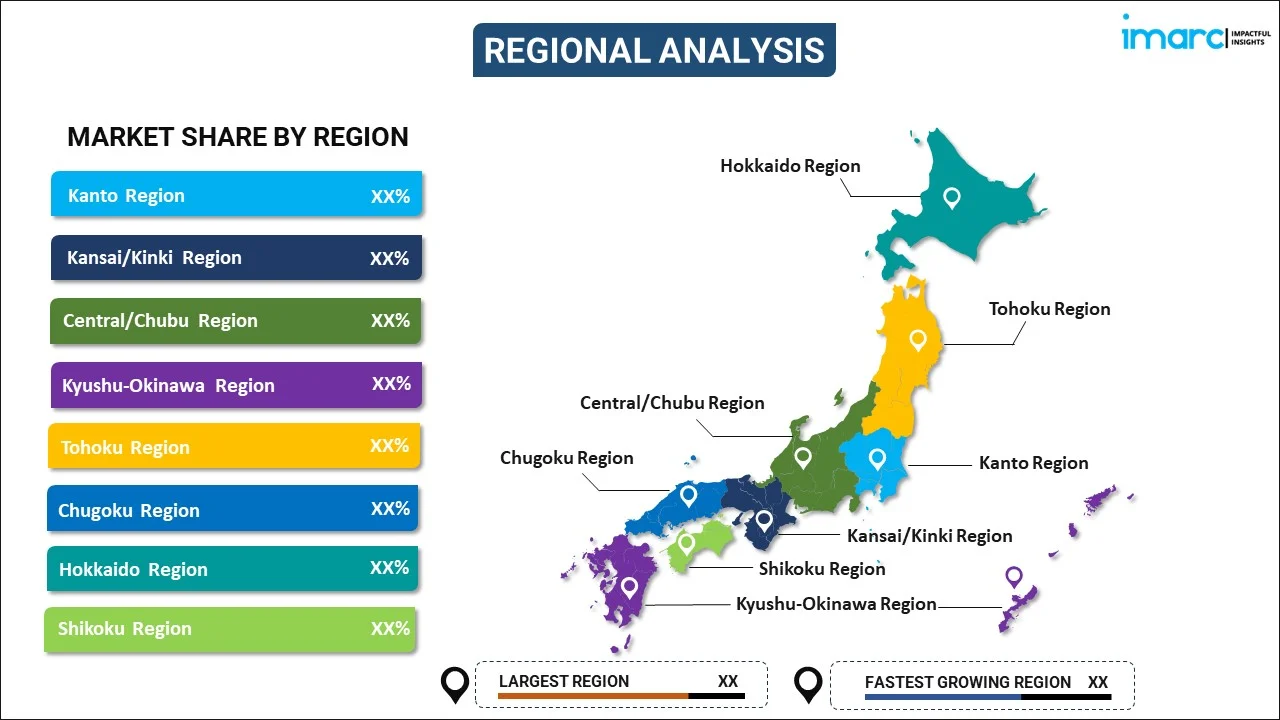
Japan Beverage Packaging Market Report by Material (Plastic, Metal, Glass, Paperboard, and Others), Product (Bottles, Cans, Pouches, Cartons, and Others), Application (Alcoholic Beverages, Non-Alcoholic Beverages), and Region 2025-2033
Market Overview:
Japan beverage packaging market size reached USD 10,367.4 Million in 2024. Looking forward, IMARC Group expects the market to reach USD 13,052.5 Million by 2033, exhibiting a growth rate (CAGR) of 2.6% during 2025-2033. The rising consumer demand for on-the-go consumption of beverages, growing health and wellness trends, increasing sustainability concerns, rapidly aging population, significant innovation in packaging solutions and rapid growth of e-commerce platforms represent some of the key factors driving the market.
|
Report Attribute
|
Key Statistics
|
|---|---|
|
Base Year
|
2024
|
|
Forecast Years
|
2025-2033
|
|
Historical Years
|
2019-2024
|
| Market Size in 2024 | USD 10,367.4 Million |
| Market Forecast in 2033 | USD 13,052.5 Million |
| Market Growth Rate 2025-2033 | 2.6% |
Beverage packaging refers to the methods and materials used to enclose and protect various types of beverages, such as soft drinks, juices, water, and alcoholic beverages. It plays a crucial role in preserving the quality, safety, and shelf life of these products while also serving as a means of branding and marketing. Typically, beverage packaging comes in various forms, including bottles (glass or plastic), cans, cartons, pouches, and even bulk containers. The choice of packaging depends on several factors, including the type of beverage, its intended use, and consumer preferences. For instance, carbonated drinks are often packaged in cans or plastic bottles to maintain carbonation, while juices and milk are commonly found in cartons or bottles.
Japan Beverage Packaging Market Trends:
In Japan, there has been escalating demand for ready-to-drink (RTD) beverages in various packaging formats, such as cans, PET bottles, and pouches, allowing for easy on-the-go consumption. This is due to the busy and lectic lifestyles of Japanese consumers that they seek convenience in their beverage consumption. Additionally, the growing health-consciousness among Japanese consumers has encouraged them to opt for healthier beverage options, including natural juices, low-sugar drinks, and functional beverages. Beverage packaging plays a critical role in preserving the nutritional integrity of these products. Other than this, with the rising environmental awareness, there is an inclination toward eco-friendly packaging solutions, such as recyclable materials, reduced plastic usage, and efforts to minimize packaging waste. Besides this, Japan has one of the largest populations globally. This demographic shift has led to increased demand for beverages tailored to older consumers, often with packaging designed for easy use and portion control. In line with this, the rise of e-commerce platforms has altered consumer purchasing habits, creating a need for packaging solutions that can withstand the restrictions of online distribution and maintain product quality during shipping. Furthermore, Japan has a rich cultural tradition of seasonal beverages and limited-time offerings. Packaging designs often reflect these cultural nuances and contribute to the marketing appeal of these products. Apart from these factors, the popular international beverage trends, such as the rise of craft beverages, premium packaging for premium products, and the emergence of functional beverages, influence the domestic market. Moreover, technological advancements in packaging, including barrier materials, tamper-evident closures, and smart packaging solutions, are driving innovation in the industry. These innovations enhance product safety, extend shelf life, and provide consumer engagement opportunities, thus creating a positive market outlook in the coming years.
Japan Beverage Packaging Market Segmentation:
IMARC Group provides an analysis of the key trends in each segment of the market, along with forecasts at the country level for 2025-2033. Our report has categorized the market based on material, product, and application.
Material Insights:

- Plastic
- Metal
- Glass
- Paperboard
- Others
The report has provided a detailed breakup and analysis of the market based on the material. This includes plastic, metal, glass, paperboard, and others.
Product Insights:
- Bottles
- Cans
- Pouches
- Cartons
- Others
A detailed breakup and analysis of the market based on the product have also been provided in the report. This includes bottles, cans, pouches, cartons, and others.
Application Insights:
- Alcoholic Beverages
- Non-Alcoholic Beverages
- Carbonated Drinks
- Bottled Water
- Milk
- Fruit and Vegetable Juices
- Energy Drinks
- Plant-based Drinks
- Others
The report has provided a detailed breakup and analysis of the market based on the application. This includes alcoholic beverages and non-alcoholic beverages (carbonated drinks, bottled water, milk, fruit and vegetable juices, energy drinks, plant-based drinks, and others).
Regional Insights:

- Kanto Region
- Kansai/Kinki Region
- Central/ Chubu Region
- Kyushu-Okinawa Region
- Tohoku Region
- Chugoku Region
- Hokkaido Region
- Shikoku Region
The report has also provided a comprehensive analysis of all the major regional markets, which include Kanto Region, Kansai/Kinki Region, Central/ Chubu Region, Kyushu-Okinawa Region, Tohoku Region, Chugoku Region, Hokkaido Region, and Shikoku Region.
Competitive Landscape:
The market research report has also provided a comprehensive analysis of the competitive landscape in the market. Competitive analysis such as market structure, key player positioning, top winning strategies, competitive dashboard, and company evaluation quadrant has been covered in the report. Also, detailed profiles of all major companies have been provided.
Japan Beverage Packaging Market Report Coverage:
| Report Features | Details |
|---|---|
| Base Year of the Analysis | 2024 |
| Historical Period | 2019-2024 |
| Forecast Period | 2025-2033 |
| Units | Million USD |
| Scope of the Report | Exploration of Historical and Forecast Trends, Industry Catalysts and Challenges, Segment-Wise Historical and Predictive Market Assessment:
|
| Materials Covered | Plastic, Metal, Glass, Paperboard, Others |
| Products Covered | Bottles, Cans, Pouches, Cartons, Others |
| Applications Covered |
|
| Regions Covered | Kanto Region, Kansai/Kinki Region, Central/ Chubu Region, Kyushu-Okinawa Region, Tohoku Region, Chugoku Region, Hokkaido Region, Shikoku Region |
| Customization Scope | 10% Free Customization |
| Post-Sale Analyst Support | 10-12 Weeks |
| Delivery Format | PDF and Excel through Email (We can also provide the editable version of the report in PPT/Word format on special request) |
Key Questions Answered in This Report:
- How has the Japan beverage packaging market performed so far and how will it perform in the coming years?
- What has been the impact of COVID-19 on the Japan beverage packaging market?
- What is the breakup of the Japan beverage packaging market on the basis of material?
- What is the breakup of the Japan beverage packaging market on the basis of product?
- What is the breakup of the Japan beverage packaging market on the basis of application?
- What are the various stages in the value chain of the Japan beverage packaging market?
- What are the key driving factors and challenges in the Japan beverage packaging?
- What is the structure of the Japan beverage packaging market and who are the key players?
- What is the degree of competition in the Japan beverage packaging market?
Key Benefits for Stakeholders:
- IMARC’s industry report offers a comprehensive quantitative analysis of various market segments, historical and current market trends, market forecasts, and dynamics of the Japan beverage packaging market from 2019-2033.
- The research report provides the latest information on the market drivers, challenges, and opportunities in the Japan beverage packaging market.
- Porter's five forces analysis assist stakeholders in assessing the impact of new entrants, competitive rivalry, supplier power, buyer power, and the threat of substitution. It helps stakeholders to analyze the level of competition within the Japan beverage packaging industry and its attractiveness.
- Competitive landscape allows stakeholders to understand their competitive environment and provides an insight into the current positions of key players in the market.
Need more help?
- Speak to our experienced analysts for insights on the current market scenarios.
- Include additional segments and countries to customize the report as per your requirement.
- Gain an unparalleled competitive advantage in your domain by understanding how to utilize the report and positively impacting your operations and revenue.
- For further assistance, please connect with our analysts.

 Inquire Before Buying
Inquire Before Buying
 Speak to an Analyst
Speak to an Analyst
 Request Brochure
Request Brochure
 Request Customization
Request Customization



.webp)




.webp)












